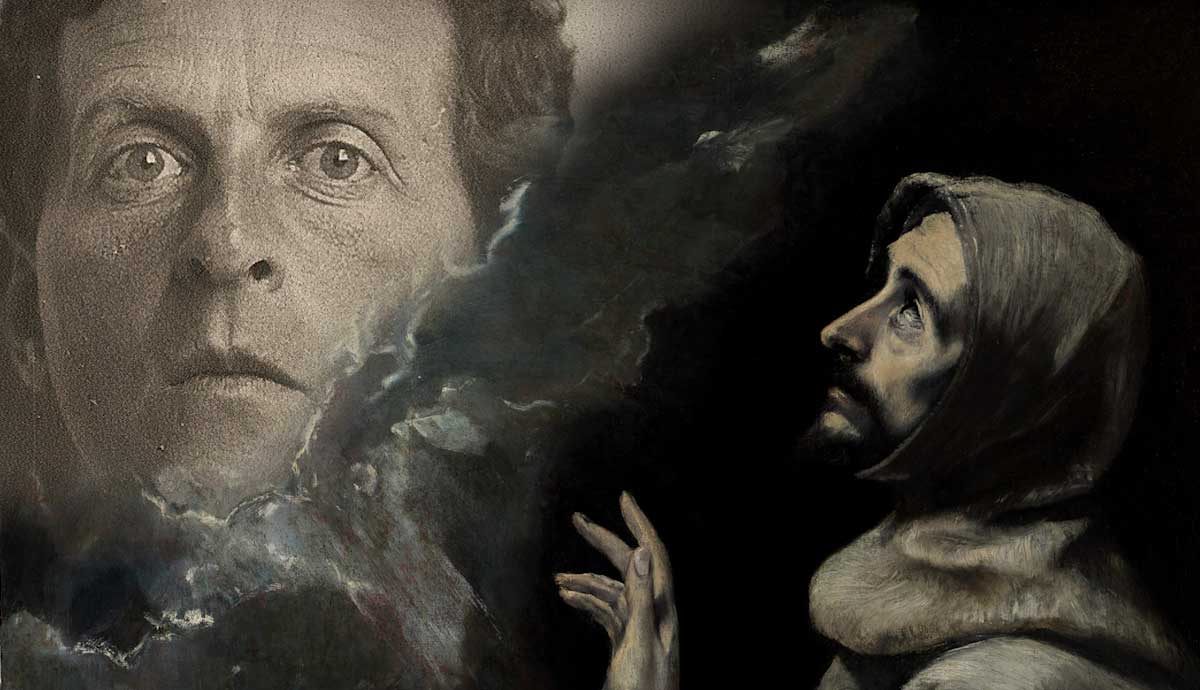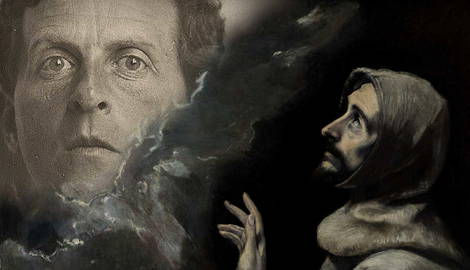
How and in what ways does mysticism permeate Ludwig Wittgenstein’s early philosophy? This article begins with a discussion of the controversy which remains over the goals of the Tractatus, Wittgenstein’s most famous early work. Having summarized two conflicting views and given a provisional definition of mysticism, the first way in which Wittgenstein’s work can be considered “mystical”—as an exercise in gesturing towards ineffable truths—is set out and discussed. An alternative conception of Wittgenstein’s mysticism is then introduced, and this article then concludes with an exploration of this alternative.
Mysticism and the Tractatus

To understand the relationship between Wittgenstein’s most notorious early work—the Tractatus—and mysticism, it is necessary to say something about the various ways in which the Tractatus’ project as a whole is understood.
What is Wittgenstein’s overall project in the Tractatus? It can be described in various ways, and apart from some very general areas of agreement, what exactly the point of the Tractatus is remains the subject of scholarly controversy. To put the same point another way—there is some agreement about the kinds of things with which Wittgenstein was concerned, but not with the ultimate purpose of the Tractatus.
There is agreement that Wittgenstein was interested in the relationship between the world and our representations of it, between language and thought. He was interested in clarifying thought and, at the same time, ridding us of some of the ambiguities of language. What all of this was ultimately in aid of—what Wittgenstein is doing in the Tractatus, what he wants us to learn from it—remains unclear.
Indeed, reading it often gives one the sense of being tantalizingly close to understanding something really important, without allowing one to settle on an interpretation of it. There are various reasons for this ambiguity, but perhaps the most important is that the Tractatus seems to be incoherent in the following way: it sets out a theory of what counts as a meaningful proposition, distinguishing that which makes sense from that which doesn’t, and then goes on to say various things which are (on this definition) meaningless.
Two Readings of Mysticism

Broadly speaking, there are two ways in which the Tractatus has been understood in light of this apparent inconsistency. Adrian Moore calls them the “Traditional” and “New” readings of the Tractatus.
The “Traditional” reading, held by (for instance) P.M.S Hacker, one of the most influential of Wittgenstein’s interpreters, has it that the Tractatus attempts to convey what cannot be conveyed. In other words, it is nonsense—but it is a kind of “illuminating nonsense” (to use Hacker’s terms), which, although failing to have sense, nonetheless somehow allows us to understand what Wittgenstein means.
This reading claims one of the most famous analogies in the Tractatus as a decisive indication that this is what Wittgenstein meant: that is, the point at which Wittgenstein describes his work as being like a ladder:
“My propositions serve as elucidations in the following way: anyone who understands me eventually recognizes them as nonsensical, when he has used them—as steps—to climb beyond them. (He must, so to speak, throw away the ladder after he has climbed up it.)”

The “New” reading of Wittgenstein’s work holds that Wittgenstein’s work in the Tractatus is absolutely not illuminating: in fact, it is meant to be exactly the opposite.
In this reading, the point of the Tractatus is to give us lots of examples of exactly the kind of thing that Wittgenstein wants to get rid of: nonsense, and most of all, nonsense that appears (and only appears) to make sense.
We can see how this interpretation can claim the ladder analogy in quite a different way. Indeed, much of what Wittgenstein says can be read from both perspectives in a more or less convincing way. Moreover, the sense one often gets whilst reading the Tractatus—that of being just about to grasp everything definitively, but never quite getting to that point—makes sense both if Wittgenstein it attempting to indirectly communicate with us, and especially if the Tractatus is a series of examples of propositions which are apparently meaningful but actually not.
It is worth observing (and here we are following Moore’s lead) that although these interpretations appear to be very different approaches to Wittgenstein’s work, on closer inspection that difference is fairly minimal. For one thing (which happens to be the most important thing for our purposes), both readings seem to imply that whatever the Tractatus imparts cannot really be said as such. In other words—the meaning of the Tractatus is ineffable.
Defining Mysticism

Here is where mysticism comes in, but before its relationship to Wittgenstein’s philosophy is explained, a provisional definition of mysticism is required. Mysticism is an element of various religious traditions, and indeed mystical experiences of a kind seem to occur even in those who have no faith, or at least no allegiance to an organized religion.
It is difficult to pin down what mysticism is in a very precise way, but the element of mysticism which is of most relevance for us is that mystical experiences are often described as allowing direct experience (of God, for instance), which cannot be conveyed in language.
This characterization of mystical experiences as knowledge of a kind that is inexpressible is where most discussions of the relationship between Wittgenstein and mysticism begin. The idea that there are parts of the Tractatus in which Wittgenstein cannot directly express what he is attempting to convey is common to both readings given above. One way of framing this is to say that he cannot just come out and say what he means, but rather must attempt to show us what he means instead. One interpretation of the Tractatus is that this is constitutive of the meaning of the text—that it resolves the dispute above with a kind of mystical element.
Mystical Elements in Wittgenstein

Take, for instance, Wittgenstein on solipsism—which for Wittgenstein is the view that one can experience the world only from one’s own point of view, and none other. Wittgenstein puts the point this way: “‘what solipsism means, is quite correct, only it cannot be said, but it shows itself.”
Much of the Tractatus can be interpreted as a self-consciously failed attempt to say what it wants to say, and yet a successful attempt at showing us it instead. This way of understanding the ineffable component of the Tractatus is, in a sense, a restatement of the “New” reading, but one in which the purpose of Wittgenstein’s “failure” lies in more than simply offering us a set of examples of what not to do.
Yet this is not the only way to understand the mystical element of Wittgenstein’s work. Indeed, there is a more thorough kind of mysticism that can be found in certain interpretations. These interpretations relate to Wittgenstein’s insistence that he is not promoting a body of doctrine, a set of claims to be accepted or rejected, but an activity and a new perspective on the world, one which allows us to think more clearly.

“The contemplation of the world…is its contemplation as a limited whole. The feeling of the world as a limited whole is the mystical feeling.”
Michael Morris and Julian Dodd have advocated this latter view, and focus on the idea of the “limit” given in the above quote. On their account, limits delineate what is necessary, possible, and impossible, and so “the limits of the world in this sense— according to the conception of language presented in the Tractatus, with its accompanying metaphysics—are nothing but the form of the world, which is the same as the general form of the proposition, and so inevitably is something which no proposition can describe.”
Mysticism and Truth in Wittgenstein’s Philosophy

Morris and Dodd are pursuing an interpretation of Wittgenstein in which they claim that he is in no way attempting to communicate anything true—indirectly or otherwise—but rather, the Tractatus is in the service of mysticism itself.
To restate the distinction between the initial conception introduction of mysticism and this view: according to the former view, the mystical element of Wittgenstein is just in the transmission of ineffable truths. On the other hand, according to the latter, Wittgenstein is advocating philosophy as an activity, the purpose of which has nothing whatsoever to do with transmitting any kind of truths, but is an end in itself in some kind of way.
In what way is philosophy an end in itself? Mystical thinking, for Wittgenstein, involves no philosophizing whatsoever. Philosophy itself is incoherent, not merely within itself and the limit conditions of meaningful expression, but also with the demands of the state of being which Wittgenstein most favors, and of which silence is the epitome.
There are various reasons why we might prefer this view. For one thing, it means we don’t need to rely on an interpretation of the Tractatus’ incoherence which recuperates some form of truth. For another, we might think that Wittgenstein’s claims to be advocating philosophy as a new activity oblige us to identify an element of his philosophy that is genuinely opposed to the kind of introspection and interiority that philosophers so often claim for their discipline.
Wittgenstein’s mysticism can be conceived of as a total commitment to activity, and a total rejection of philosophy’s value. However, this is far from a definitive interpretation.
FAQs
How do other interpretations of the Tractatus view the role of mysticism?
Some interpretations of the Tractatus argue that mysticism is central, highlighting Wittgenstein’s view that the most important aspects of reality lie beyond language’s reach. This perspective sees the unsayable as key to understanding the world, emphasizing the limits of logic and the significance of the ineffable.
What is the connection between Wittgenstein’s later philosophy and mysticism?
Wittgenstein’s later philosophy, particularly in his work “Philosophical Investigations,” suggests that some aspects of human life, like ethics and aesthetics, are beyond the reach of language. This resonates with mysticism, which often holds that the most profound truths are ineffable and can only be understood through personal experience.
Are there specific examples from the Tractatus that both interpretations use to support their claims about mysticism?
Yes, both interpretations of Wittgenstein’s Tractatus Logico-Philosophicus regarding mysticism often cite his proposition 6.522: “There are, indeed, things that cannot be put into words. They make themselves manifest. They are what is mystical.” This statement is used to argue for the presence of mystical or ineffable elements in his philosophy.










